FEATURE NT traditional owners urge climate change policy makers to witness mangrove devastation

AUSTRALIA – Traditional owners are devastated by the lack of recovery at the site of Australia's worst recorded mangrove dieback and are calling for action to limit climate change threats. Traditional owner Patsy Evans had hoped there would be signs of recovery at the site of the mangrove dieback, in the Gulf of Carpentaria. But during a recent visit to the area for the first time since 2015, when she and her husband alerted the Northern Territory Government to the extent of the damage, she was devastated by the scene. She said she wanted policy makers to see how climate change was affecting the land near her home on the Limmen River, 750 kilometres south of Darwin. "Go out and see what's happening, be aware and look at it, and don't make decisions where you are," she said. The mangroves were once nurseries for the mud crab, barramundi and prawn fisheries, but now consist mainly of dead trees and dusty earth. The few live seedlings coming through are exposed, and vulnerable to damage from the fallen dead trees. Scientists from Queensland and Northern Territory universities said one contributing factor was a temporary drop in sea levels, caused by a change in the trade winds, which left the forests unusually high and dry. But they said another factor in the dieback along 1,000 kilometres of coastline was climate change and a sharp increase in the sea temperature. READ MORE
GLOBAL
Latest from the Connected Mangroves reforestation project
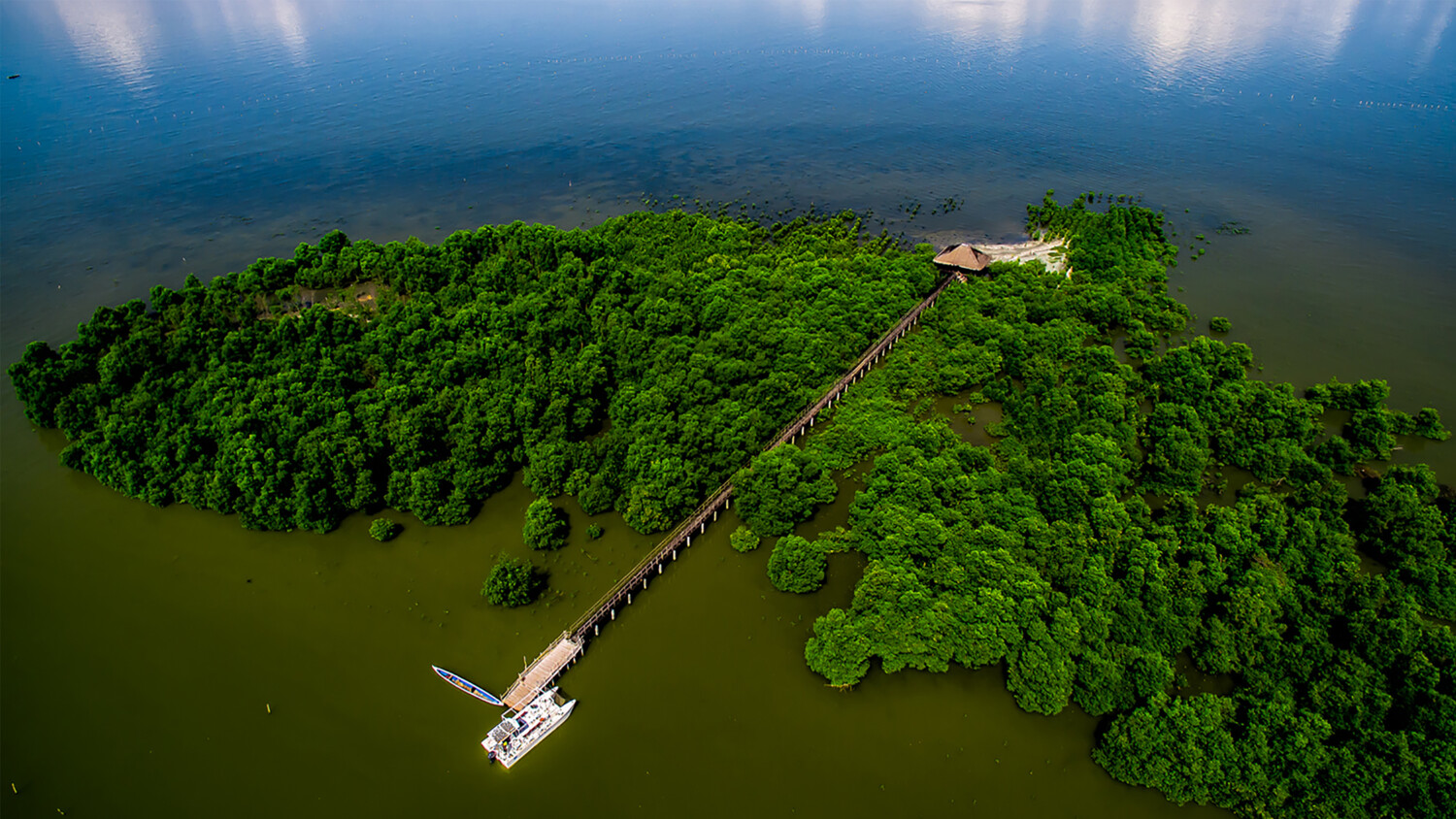
GLOBAL – The last time we saw black-faced spoonbills in the Pampanga river in the Philippines was more than 100 years ago. These coastal birds, found only in East Asia, have been classified as an endangered species since 2000. Owing to the impacts of deforestation, pollution, and man-made industries in what was once their breeding grounds, their populations are predicted to decline even further in the future. However, in early 2019, the community of Sasmuan in Pampanga was greeted by the sight of three of these endangered species flying over the river. This area, in particular the Bangkung Malapad islet mangrove forest, is the site of the Connected Mangroves reforestation project between Ericsson, Smart Communications, and the local government unit of Pampanga. Connected Mangroves is a reforestation project which leverages connected technologies such as solar-powered sensors and real-time camera footage to collect critical data and present it to local communities on a digital dashboard. Initiated in 2017, the project offers the local community a platform to check on water, soil and humidity conditions, and remotely monitor any intrusion on the site. We began this reforestation project with the intention to see just how far we could go in mangrove restoration efforts by harnessing the power of mobile technology. READ MORE
AFRICA
Restoring Earth's natural defenders
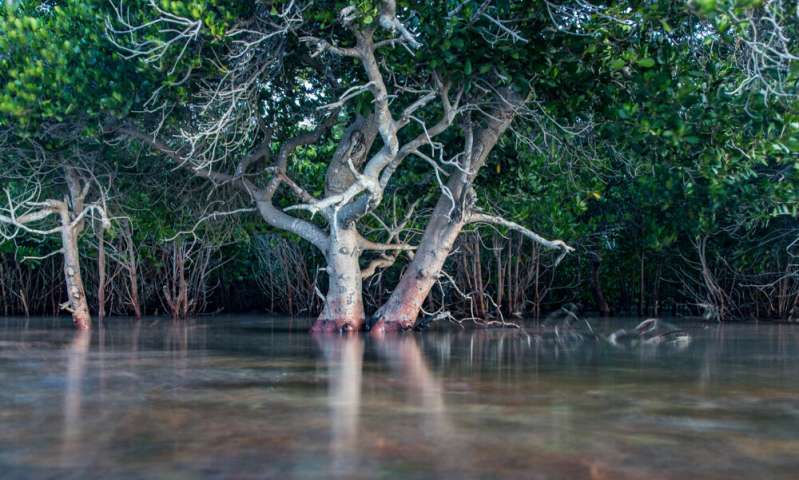
KENYA – It's no secret that the forests of the world are under severe pressure from human activities. We tend to think of tropical forests, and in particular the Amazon, as bearing the brunt of the impacts of deforestation and other drivers of forest clearance. While tropical forests are faring badly, there is another forest type that has been subject to more degradation and destruction than any forest type on Earth over the last 50 years: mangrove forests. In northern Kenya, FFI has partnered with the Northern Rangelands Trust to support Pate Island Conservancy in addressing the significant threat posed by the unsustainable extraction of mangroves for firewood and poles used in construction. Efforts to reduce illegal exploitation have so far focused on increasing the number of patrols carried out by local rangers, which has enabled suspects to be apprehended. Additionally, a total of 35,250 seedlings were planted between 2015 and 2018. The protection and restoration of mangroves is critical to the fight against climate change, as well as central to ensuring local communities are protected from climate impacts. Mangrove forest protection will also ensure that local communities continue to benefit from the livelihoods provided by these ecosystems. READ MORE
AMERICA
Florida mangroves reveal complex relationship between climate and natural systems

USA – angroves are tropical, salt-tolerant trees that grow in the intertidal zone of coastal waters. They don’t tolerate cold weather, particularly extreme freezes, during which they die and get replaced by coastal salt marshes. In the 1980s, a series of freezes caused the most recent major die-off of Floridian mangroves (and citrus crops, which also fare poorly in cold weather). Since then, previous research showed, mangroves have flourished and expanded further from the tropics. As global temperatures continue rising, noting where mangroves and similar trees and vegetation flourish can serve as a marker to monitor the effects of climate change. A new study led by UCLA’s Kyle Cavanaugh of how Florida’s mangroves and salt marshes are affected by changes in climate, both man-made and natural, illustrates the complex interplay between our changing climate and living natural systems. The paper, which was published in PNAS, found that decades-long, natural climate cycles have determined the northern extent of Florida mangroves for at least the past 250 years. Freeze events that took place approximately every 10 to 30 years caused die-offs, during which mangroves were replaced by salt marshes until warmer trends spurred regrowth. READ MORE
Florida Alum develops clothing with a cause: mangroves
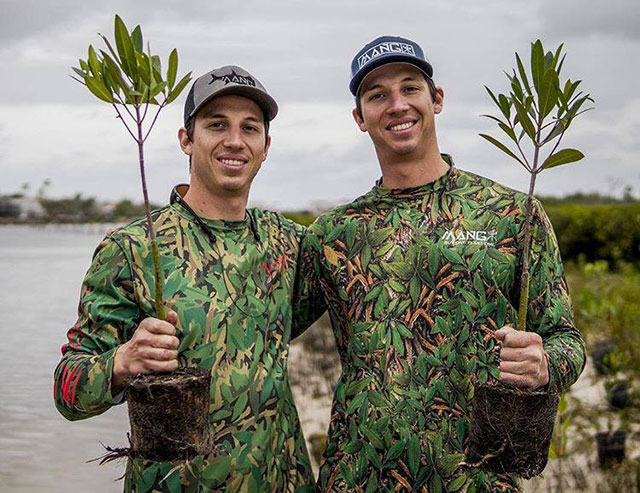
U.S.A. – Kyle Rossin wears his heart on his sleeve: Mangroves cover the arms and body of his moisture-wicking, ultraviolet-light-shielding polyester shirt. Restoring these plants vital to Florida’s fragile coastal ecosystem is Rossin’s passion as well as his entrée into entrepreneurship. That camouflage-print shirt patterned after mangroves — “Mangroflage,” they call it — planted the seed for MANG gear, a line of fishing apparel that the 2015 FGCU grad and his brother, Keith, launched as a way to raise money to restore mangroves. For each product sold, the company plants a mangrove. So far, close to 60,000 have been placed in vulnerable areas of Florida, Madagascar, Honduras, Indonesia and Mozambique. Keith, left, and Kyle Rossin launched MANG apparel to support mangrove restoration. “Keith and I wouldn’t be in the apparel industry for any other reason,” Rossin said. “We had no desire to sell apparel. We thought we’d make a T-shirt, and it would be a one-off thing. The opportunity to plant mangroves and teach people about their importance to the environment is our real mission.” READ MORE
ASIA
Phuket residents force ‘ring road’ to avoid mangroves, houses

THAILAND – Local residents in Pa Khlok have voted against the last stage of four-lane “ring road” being paved through the area from passing through mangroves, forcing the Highways Department to redraw its plans and resubmit them for approval. The “ring road” project to expand Route 4026 through Pa Khlok at a cost of B720 million aims to ease the expected impending traffic congestion when construction of the Phuket light-rail finally begins. The affected section of the road is a stretch of 140 meters that was to be elevated as it passed through a mangrove forest covering about 217 rai, Phuket Highways Office Director Somwang Lohanut told The Phuket News. The people want to preserve the mangroves in their community, which is the major reason for them requiring this project to keep clear of mangroves,” he said. “We have presented them an alternative route which goes around the mangrove forest, avoiding the mangroves entirely” Mr Somwang added. Initially, the plan was for the road to be elevated and pass directly through the mangroves, but due to objections from local residents an alternative route which passed through a smaller part of the mangrove forest was present – but that too was rejected, Mr Somwang explained. READ MORE
In 5 Years, Fisherman Plants 75000+ Mangrove Trees Along Kerala’s Coast

INDIA – Environmental crisis is looming higher on the horizon with unpredictable natural disasters, extinction of species and increased global warming. It’s time to accept that climate change is real you guys and if we don’t work toward conserving the planet, we’ll slowly see the world disintegrating right in front of our eyes! Thankfully, there are enlightened and proactive souls who relentlessly work toward mitigating this crisis in full force! A case in point is Murukesan TP, a 53-year-old fisherman who has helped in the plantation of over 75,000+ mangrove trees across coastlines, brackish water areas and forests. The fisherman from Vypin, Kerala, works with the Social Forestry Department in the Ernakulam district in plantation drives. He has also created a small nursery at his home where he grows over 15,000 saplings in a year, which he sells to the Forest Department for Rs. 14 per sapling. “I started doing this because of environmental concerns. Cyclones are becoming more frequent and pollution is increasing rapidly. Mangroves, which are common here, were drastically reducing in number,” says the concerned fisherman. READ MORE
Group launches project to plant mangroves in Mon

MYANMAR – An international conservation group has started a pilot project planting mangroves along the Gulf of Martaban coast in Mon State. The Worldview International Foundation said it will plant about 12,000 hectares of mangroves along the coast in Thaton and Bilin townships. The group has already planted 100 hectares. “We will plant mangroves on the mud flats where the floods have left a thick deposit of sediment,” said U Win Maung, project manager of the foundation. Official data showed that between 1980 and 2015, mangroves covered 76 percent of Rakhine State’s coast, 29pc of Ayeyarwady Region’s coast, and 98pc of Tanintharyi Region’s coast. But the country’s mangrove forests are fast disappearing due to human activity and the effects of climate change. The northern Gulf of Martaban is a Ramsar Site, which designates it to be of international importance and a conservation area under the 1971 UNESCO Ramsar Convention. U Win Maung said that developing mangrove forests on the gulf will benefit people as it will protect coastal communities from storm surges and mitigate global warming as a carbon sink. It will also help in the government’s poverty reduction efforts by providing local people with livelihoods. READ MORE
5,619 mangrove trees will need to be cut for Gorai-Borivli bridge

INDIA – The state’s coastal authority has said that the most optimal alignment of the proposed bridge between Gorai island and Borivli will require 5,619 mangrove trees across 2.8 hectares (ha) to be cut. A local activist group has alleged more trees will be affected although one of the conditions imposed on project proponents Mumbai Metropolitan Region Development Authority (MMRDA) is planting five times the number of mangroves lost. A 500-metre bridge from Borivli to Gorai village has been proposed to improve connectivity and reduce travel time from one hour and 10 minutes by road to 35 minutes. The ₹575-crore project was sanctioned on August 23. “There is no direct road connecting Gorai village and Borivli. This bridge will be an important link not only for local residents, but larger public interest, and enhance tourism,” a member of the Maharashtra Coastal Zone Management Authority (MCZMA) told HT. READ MORE
EUROPE
London solidarity action to Save the Sundarbans blocked Banlgadesh high commission
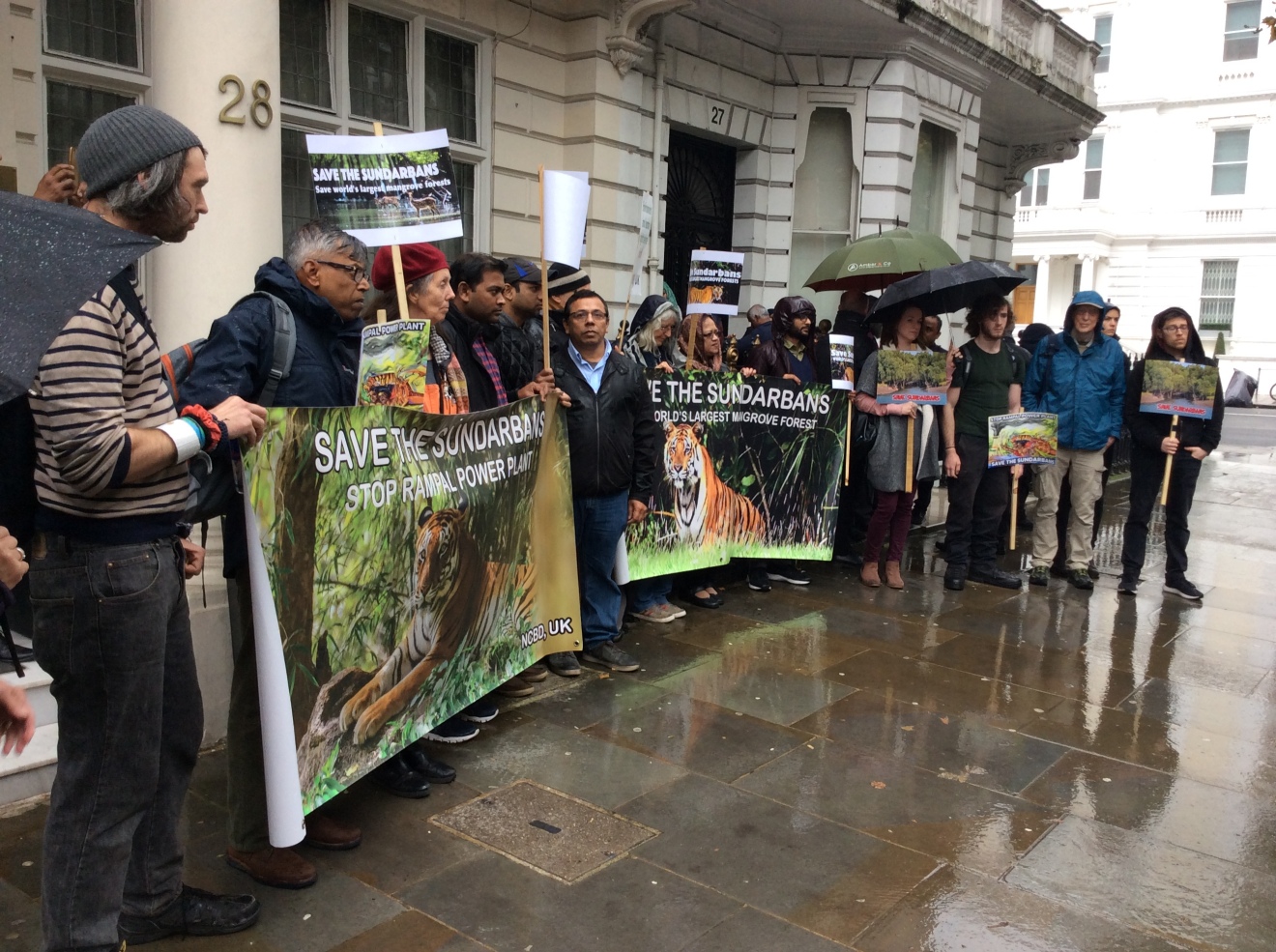
U.K. – Amidst heavy policing and non-stop rain passionate climate and mangrove rights activists have blocked the main entrance of the Bangladesh High Commission in London today for three hours. A powerful and noisy solidarity action by London based transnational campaigners condemn the Bangladesh government’s decision to implement the 1,320 MW Rampal coal power plant as it would destroy the Sundarbans in Bangladesh. Protesters echo calls in their memorandum signed by members of 30 participating organisations demanding the Bangladesh government must put immediate halt to the Rampal project and take responsibility to save the Sundarbans. A representative of five non-violent Bangladeshi protesters wanted to hand in the memorandum to the High Commissioner, Ms Saida Muna Tasneem, asking her to convey their five-point demand to the government, but she refused to make herself available to activists. Bangladeshi citizens were turned away, and denied access to the building and harassed by privately hired security guards and police which the activists called appalling. READ MORE
LAST WORD
Hello Alfredo Quarto, my name is Orobuibi Ben Orutemeka. I live and work in the Niger Delta, Nigeria.
I am sending some photographs to portray the effect of oil pollution on the Blue Carbon ecosystem of the Niger Delta, and how it has impacted on the livelihoods of families and communities.
Prompt action is needed to save the mangrove. The flare you experienced, first hand, over ten years ago is still on going. In adding, illegal or artisanel refiners have virtually occupied the adjoining creeks and estuaries as their operational “dumps”.
The activity of “kpo fire” (as it is locally called) and the aerial bombardment of oil dumps and receptacles, including petroleum bearing tankers by gunship belonging to Joint Task Force, JTF oftentimes cause air and water pollution. The mangrove is the worse hit. There is dwindling fishing activity in coastal communities.
There is the need to support the indigenous peoples efforts to restore the mangrove forest of the Niger Delta so as to sustain their only means of livelihood. International organisations such as Mangrove Action Projects, MAP should partner with local communities to sensitize mangrove communities, multinational oil corporations and governments at the Local, State and Federal levels on the need to act fast.
MAP will be adding value to Ogu/Bolo Mangrove Reforestation Project through provision of technical support, outreach programs and empowerment. Orobuibi Ben Orutemeka 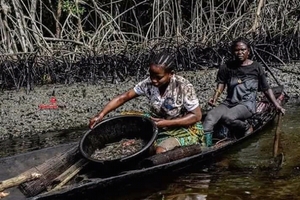 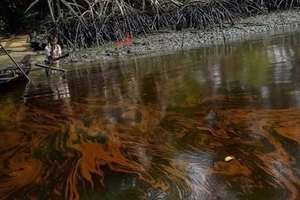 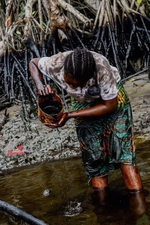
Like this newsletter?
Pease consider donating to MAP to keep it going.
Giving could never be easier | ACTION ALERTS PETITION – NO new coal power – protect local people and wildlife!
SIGN OUR PETITION PETITION – Help stop the advance of oil palm plantations in Gabon!
SIGN THE PETITION PETITION – Don't trash coral reefs for the cruise industry! – TAKE ACTION PETITION – Sea turtles or condominiums?
Sand mining and construction work would wipe out a marine biodiversity hotspot and destroy the livelihoods of local people, who have not been consulted. Please SIGN! PETITION – Save Penang! Reject the 3-Islands Reclamation!
The lack of public consultation and detailed information about the project is shocking in view of the size of proposed reclamation which is 4,500 acres or 7 square miles
PLEASE SIGN
PETITION – Save Pulau Kukup National Park – second largest mangrove island in the world. Sign The Petition Like this newsletter? Pease consider donating to MAP to keep it going. Giving could never be easier 
69 million tons of carbon stored thanks to mangrove restoration, as demonstrated by the new Mangrove Restoration Map VIEW MAP HERE 
Restoring The Natural Mangrove Forest
Watch movie 
Community Based Ecological Mangrove Restoration in Rufiji Delta VIEW VIDEO Video: Mangroves for the Future – A look bacK. As the latest phase of Mangroves for the Future (MFF) draws to a close, this video highlights some of the project’s most successful initiatives – from local women supporting national park management in Viet Nam to an island in the Maldives that has become a model for waste management, and everything in between. View Here WANT TO GET INVOLVED?
Follow and Join MAP!
   
Like this newsletter? Pease consider donating to MAP to keep it going. Giving could never be easier 

VOLUNTEER OPPORTUNITY 
MANGROVE ISSUES Want to learn more about mangroves?
Our short presentation will give you a better understanding of the issues we are working to solve. WATCH PRESENTATION What is CBEMR? Easy to follow fact sheet – CLICK HERE What is EPIC? – The Ecosystems Protecting Infrastructure and Communities (EPIC) project: the role of ecosystems as protective barriers against climate induced hazards MANGROVES APP AVAILABLE
A pictorial field guide for easy identification of various mangrove species and learning about the mangroves ecosystem. CLICK HERE View MAP’s uploaded Videos at MAPmangrover’sChannel
Question Your Shrimp Consumer/Markets Campaign!
WATCH VIDEO Mangrove Restoration in Asia – Watch Short Video The Value of Mangrove Forests View Video CBEMR Experience Exchange MAP 2017 English Subtitles
VIEW THE VIDEO Mangroves: Guidebook to Malaysia – Click Here
Mangrove rehabilitation in Asia – Local Action and cross-border Transfer of Knowledge for the Conservation of Climate, Forests and Biodiversity VIEW VIDEOS HERE SHARE MAP'S VISION
CLICK HERE to watch short introductory video. Together we can work "at the roots of the sea". Our short documentary, Reducing the Risk of Disaster through Nature-Based Solutions : Mangroves

Exclusive Interview with Alfredo Quarto, Co-Founder and Executive Director of Mangrove Action Project – See more
Marvellous Mangroves Curriculum The Marvellous Mangroves Education Forum is an online hub for those utilizing the Marvellous Mangroves (MM) Curriculum. It gives students, teachers and anyone interested in mangroves, the opportunity to learn and share ideas themed around the curriculum, to connect and communicate with others around the globe whilst exploring mangroves from your computer or on the go. VISIT 
The award-winning Marvellous Mangroves (MM) curriculum educates children on the importance of mangroves and their ecological functions, teaching them about modern challenges and mechanisms for sustainability. VIEW VIDEO Marvellous Mangroves Curriculum in Bangladesh – WATCH VIDEO
MARVELLOUS MANGROVES IN BRAZIL
En Portuges 
Marvellous Mangroves – A Curriculum-Based Teachers Guide. FOR MORE ON MAPs AWARD WINNING CHINA MANGROVE CURRICULUM VISIT

VIMEO SHOW
VISIT OUR "MM" WEBPAGE Check out our presentation for more details on Marvellous Mangroves Read this 10 page history of the development of MAP’s educational curriculum VIEW DOCUMENT
Article in Canada's Green Teacher Magazine – Read More
Like this newsletter? Pease consider donating to MAP to keep it going. Giving could never be easier 
Green Planet Fundraising Assists MAP – LEARN MORE
Volunteer Opportunities with Mangrove Action Project CLICK HERE
"Question Your Shrimp" Campaign Question Your Shrimp- Don't Buy or Sell Imported Tropical Shrimp! Sign the Petition Learn more about the affects of the shrimp industry on mangroves by visiting our blog
Editor’s Note: Mangrove Action Project’s Executive Director, Alfredo Quarto was interviewed about shrimp by Green Acre Radio’s Martha Baskin
LISTEN TO INTERVIEW Sign the Consumer's Pledge to avoid imported shrimp
Not yet a MAP News subscriber?
Click here to subscribe. Note to Our Readers: We strive to keep active links in our newsletter. However, due to circumstances beyond our control, occasionally links to stories may become broken. If you find a link to a story is not functioning, please cut and paste the headline into your browser search bar. In most cases you should be able to locate the original story.
|




























